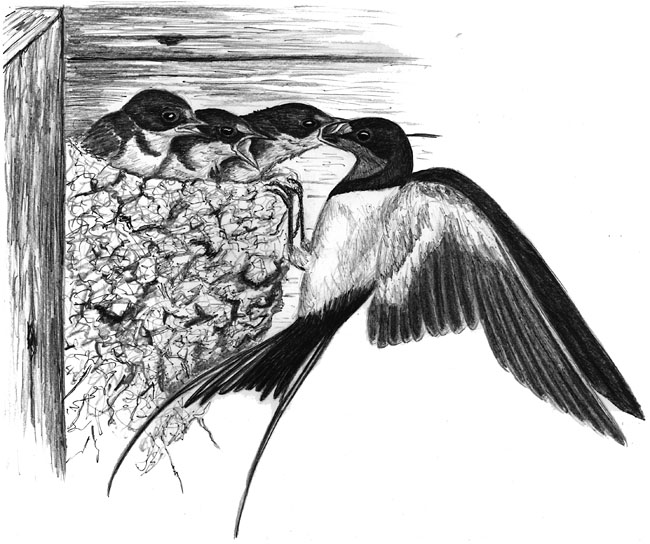
Dear Bird Folks,
Please write a column about Barn Swallows. They are my favorite birds. I look forward to their return each spring and I’d like to know more about them.
– Merton, Brewster, MA
I’m with you, Merton,
Sometimes birders play this game in which each person pretends to be moving to her or his own private island. The island is very pleasant, but it only can have a maximum of ten different species of birds on it. Each person has to select which ten species they want. (Forget bungee jumping or skydiving; this is a birder’s idea of cutting-edge excitement.) It sounds lame, but the game does produce some interesting conversations as each participant explains why she/he chooses, say, a Phainopepla over a Blue Jay. Whenever I participate in this game my choices tend to be different each time I play. However, the Black-capped Chickadee (of course) and the Barn Swallow are always on my list. Like you, I very much enjoy Barn Swallows. They are pleasant, energetic birds that actually appreciate people. Besides, who wants to be on an island with a bunch of Phainopeplas? It’s hard to even say Phainopepla without spitting.
Believe it or not, there are about seventy-five different species of swallows in the world. Some swallows are rather fancy looking, while others are plain. But if you stopped people on the street, anywhere in the world, and asked them to draw a swallow, they would instantly draw a Barn Swallow (either that or call the police). Barns Swallows have the classic “swallow” shape and can be found on every continent, except the frozen one. Here in the U.S., Barn Swallows breed from Alaska to Texas to Brewster. These adventurous swallows will occasionally even find their way to Hawaii, but not too often. (It’s hard for them to fly with those flowered leis around their necks.)
Historically, Barn Swallows built their nests in caves, but caves are cold, damp and scary. The minute humans started constructing less damp and less scary structures, the birds quickly moved in. Today, swallows use very few natural caves and instead breed in all sorts of man-made buildings. In addition to barns, swallows use sheds, stables, porches and even highway bridge abutments. In fact, early ornithologists wanted to call these birds “Highway Bridge Abutment Swallows,” but a coalition of barn builders pressured them into changing their minds.
Because Barn Swallows are insect eaters, they are forced to leave here during our bug-less winters and fly to bug-rich South America. But don’t worry; they aren’t gone for long. When spring and the bugs return, so do the swallows. The first swallows begin to arrive in mid-April (that means right now). Some folks think the early-arrivers are “scouts,” but the idea of sending advanced scouts is not really the birds’ style. Remember, we are talking birds, not the U.S. Cavalry. A swallow isn’t going to fly hundreds of miles north, check out the situation and then fly all the way back to tell the other swallows the coast is clear. The early birds are just early birds and that’s all. Typically, the older males are the first ones to reach the breeding grounds and they aren’t about to encourage other swallows to join them. (Well, no other swallows except for maybe a few females.)
Cape Cod has five species of breeding swallows and all of them can be seen swooping across our open fields. However, Barn Swallows are the only ones with the signature “swallowtail.” Their forked tails are 3”- 4” long, with the males’ tails being about an inch longer than the females’. (Good luck trying to figure out which is which as the birds fly by at a zillion MPH.) Unlike their cousins, the Tree Swallows, Barn Swallows have a touch of claustrophobia and thus they don’t use birdhouses. Nevertheless, they still like to have a roof over their heads, which is why they nest in our buildings. Sometimes I get calls from folks who complain when a swallow builds a nest in their shed or garage. People whine, “The birds’ droppings are making a mess.” I tell them to calm down; it’s just bird poop, not radioactive acid. I suggest they simply put a small drop cloth under the nest and everything will be fine.
In addition to buildings, open areas and insects, swallows need mud. Mud is a key ingredient for nest building. Both parents fill their beaks with fresh mud, add a bit of dried grass, form it into a ball and then attach it to a beam or some other structure. A great way to attract Barn Swallows is to add a muddy patch in the corner of your garden. The birds will make hundreds of visits, each time filling their beaks with loads of gooey mud. (That’s why you should back away if a Barn Swallow looks like it’s going to sneeze.)
As with Purple Martins, many people think that swallows eat lots of mosquitoes. But regrettably, this isn’t the case. Swallows feed during the day, whereas most mosquitoes work the nightshift. The two rarely see each other. In addition, swallows tend to go after larger prey, such as nasty horseflies. I know it would be great if swallows ate mosquitoes, but at least they eat horseflies and they are nearly as bad…especially if you happen to be a horse.
I’m glad you like Barn Swallows, Merton. They are wonderful little birds and lots of fun to watch. And while they are a lot fun, they aren’t nearly as much fun as sitting around with a bunch of birders talking about which birds they want to take with them to a private pretend island…but what is?